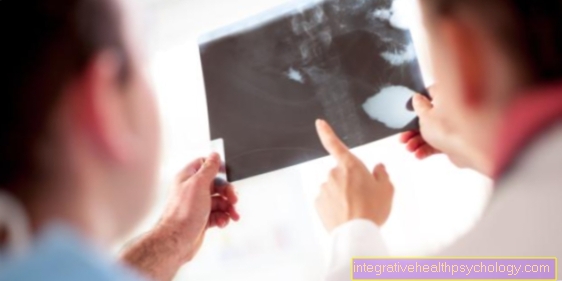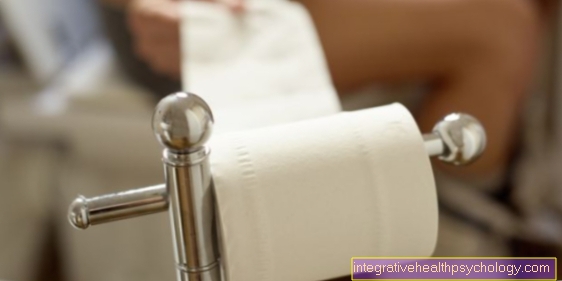Therapy rheumatoid arthritis
Note
This topic is the continuation of the topic:
- Rheumatoid arthritis
Synonyms in a broader sense
- Rheumatoid Arthritis (R.A./ RA)
- chronic polyarthritis (c.P. / cP)
- Rheumatic disease, primarily chronic polyarthritis (pcP / p.c.P.)
English: Rheumatoid arthritis, rheumatism
Therapy rheumatoid arthritis
The therapy is based on the activity of the inflammation and the stage of rheumatoid arthritis (RA). Furthermore, the patient's individual response and accompanying illnesses must of course be taken into account.
The aims of therapy are to slow down the inflammatory process, relieve pain and, if possible, maintain the function and strength of the joints.
The therapy of primary chronic polyarthritis always covers several areas:
- physiotherapy
- Occupational therapy / splint supply / aid supply
- Physical therapy
- Psychosomatics
- Systemic and local drug therapy
- Operations
physiotherapy
Should be adapted to the respective disease activity and discussed with the doctor. In the case of high disease activity, only passive movement of the joints, traction for pain relief and painless positioning are usually used.
In the case of low disease activity, active movement exercises should be carried out to stabilize, mobilize and compensate for muscle loss, some of which the patient can also do himself. Furthermore, the use of aids, e.g. Forearm crutches (UAGs) are practiced after operations.
Occupational therapy / splint supply / aid supply
In occupational therapy, the patient trains everyday functional functions that he needs to integrate into everyday family and professional life. The therapy is individually adapted to personal performance. There is gait and back training as well as measures for joint protection are shown. The use of tools, devices or aids is also practiced or splints are made. Storage rails are available, but also dynamic rails for training the joint function. Walking aids come e.g. Knee bandages or crutches in question. Often shoe supplies are also necessary, e.g. Insoles, metatarsals or buffer heels. Further aids are e.g. Cutlery with a thickened handle, button closers, pull-up rod, etc.
Physical therapy
For pain relief and muscle relaxation, e.g. Heat or cold therapy, Electrotherapy, medicinal baths, massage, ultrasound / sonography, exercise bath.
Psychosomatics
The aim of this is to prepare the patient for a life with rheumatoid arthritis and to strengthen the patient's willingness to cooperate with the therapy. Furthermore, relaxation techniques (e.g. progressive muscle relaxation according to Jacobson) are taught and pain management techniques are learned.
You can find more information on our other topics:
- Progressive muscle relaxation according to Jacobson
Medical therapy
Of course, drug therapy must also be adapted to the disease activity.
Non-steroidal anti-inflammatory drugs (NSAIDs) are used to relieve pain and joint stiffness. Medicines in this group are DIcolfenac, ibuprofen or the newer COX 2 inhibitors Celebrex ® and Arcoxia ® 90mg. In the case of low disease activity, they can be taken as needed, with medium and high disease activity, they should be taken regularly.
If the inflammatory activity cannot be contained with this, the additional intake of steroids is necessary. Steroids (cortisone) have strong anti-inflammatory and immunosuppressive effects. The dose should be adjusted depending on the disease activity. When taking steroids (cortisone), in order to achieve the optimal effect and to keep the side effects as low as possible, the following should always be observed:
- Dose: as low as possible, as much as necessary
- the entire daily dose should be taken early in the morning with milk or yogurt
- the intake should not simply be stopped without consulting a doctor
- regular check-ups with the doctor
- see a doctor immediately in the event of acute illness or pregnancy
- watch out for back pain and report it to the doctor
- as much physical activity as possible
- weigh daily
With regular steroid therapy (cortisone therapy), medical osteoporosis prophylaxis is recommended. This should be done with calcium, vitamin D (e.g. Ideos®) as well as a bisphosphonate (e.g. Fosamax ®) or selective estrogen receptor modulators (e.g. Evista®).
With any active chronic polyarthritis, long-term disease-modifying antirheumatic drugs (DMARDs) are also indicated.
The principle of action of these drugs is usually not known, but the activity of rheumatoid arthritis is weakened, whereby the onset of action is often only noticeable after weeks. Close medical supervision is necessary because of the sometimes serious side effects.
Long-term disease-modifying drugs include:
- with low disease activity:
- Chloroquine (e.g. Resochin®)
- Hydroxychloroquine (e.g. Quensyl®)
- Oral gold (e.g. Ridaura®)
- with moderate disease activity:
- Sulfasalazine (e.g. Pleon® RA)
- Gold parenteral (e.g. Tauredon®)
- Azathioprine (e.g. Imurek®)
- with high disease activity:
- Methotrexate (e.g. Lantarel®)
- D - penicillamine (e.g. Metalcaptase®)
- Ciclospoprin A (e.g. Sandimmun® Optoral)
- Leflunomide (e.g. Arava®)
- with highly acute disease activity:
- Cyclophosphamide (e.g. Endoxan ®)
- TNF - alpha receptor antagonists (e.g. Remicade®, Enbrel®)
In the event of ineffectiveness or diminishing effectiveness, a product change can be carried out or the DMARDs can also be combined with one another.
During therapy with methotrexate, undesirable side effects can be countered with folic acid preparations without loss of effectiveness.
Further information can be found under our other topics:
- NSAIDs
- Voltaren
- Ibuprofen
- osteoporosis
- Methotrexate
Local drug therapy
In the acute stage, you can apply refrigerator-cold compresses to the affected joint several times a day NSAIDs - gels (e.g. Voltaren ® Emulgel) or cold quark. In chronic stages, use ointments that promote blood circulation (e.g. Thermo Reumon ® Creme).
In the case of acute involvement of one or a few joints, the doctor can perform intra-articular injections (injection into the joint) of local anesthetics (= local anesthetics) and steroids (cortisone).
Another therapy option is the synoviorthesis (= obliteration of the inflamed joint mucosa). Sclerotherapy drugs (e.g. morrhuate or osmic acid) = chemosynoviorthesis or radionuclides (e.g. yttrium 90, rhenium 186 or erbium 169) = radiosynoviorthesis are injected into the joint.
Tendon sheaths or tendon attachments can be infiltrated locally with a local anesthetic and, if necessary, a water-soluble steroid (cortisone).
Further information can be found under our other topics:
- Chemosynoviorthesis
Homeopathy and rheumatoid arthritis
Also rheumatic diseases can through homeopathy be treated. Of course this can make a Rheumatoid arthritis not cured, but the symptoms of the disease are significantly alleviated.
Read more about this interesting topic: Homeopathy for rheumatism
Diet can also play a role in rheumatoid arthritis.
Operative therapy
Operations for rheumatoid arthritis are always necessary when drug therapy can no longer adequately contain the inflammatory activity. Operations are relatively urgent if there are pronounced axial deviations of a joint (e.g. pronounced knock-knees) or the joint destruction is progressing rapidly. Even if there is a risk of tendon ruptures or neurological failures, surgery should not be delayed too long.
Multiple operations are often necessary for rheumatoid arthritis. Sometimes combination interventions can be carried out, otherwise, when determining the sequence, if the need for an operation is equivalent, interventions on the legs should be performed first to ensure that the patient is able to walk. Furthermore, joints close to the trunk should first be operated on, then the joints further away from the trunk, e.g. the wrist in front of the finger joints, because if the wrist is unstable, the function of the fingers will always be limited despite a successful operation.
One differentiates:
- joint protective interventions
- Joint surface correcting interventions
- joint resection operations
- joint replacement interventions
- joint stiffening interventions
Depending on the joint and the stage of destruction of the joint surfaces, the doctor will suggest the appropriate intervention.
Interventions to protect the joints are e.g. synovectomy and tenosynovectomy. The inflamed synovial membrane or the inflamed tendon sheath tissue is radically surgically removed. The inflammatory flare-up of the disease is interrupted. This stops the cartilage-destroying process and the destruction of the bone and reduces the swelling-related overstretching of the joint capsule and the ligaments that guide the joints. The tendons are protected from tendon rupture by removing the inflammatory tissue that has penetrated the tendon. These interventions are indicated as long as the joint surfaces are still intact and joint swelling has persisted for at least 6 months despite consistent drug therapy.
Interventions to correct the joint surface are aimed at achieving a uniform load on the joint parts again in the case of strong axial deviations, or in the case of limited cartilage damage, to remove this from the main load zone. For this purpose, the bone is severed and stabilized in the corrected position with screws / plates / wires. As a rule, these interventions are mainly performed in younger patients and combined with a synovectomy. Since the inflammation in rheumatoid arthritis / primary rheumatoid arthritis affects the entire joint equally, interventions to correct the joint surface area (except for the forefoot) are rarely performed in rheumatoid arthritis.
Joint resection operations are performed when the joint surface is destroyed but the ligaments, joint capsules and muscles are still well preserved. The destroyed joint parts are removed, the joint surface is reshaped and replaced by an interposal made from the body's own tissue (e.g. capsular tissue, fatty tissue, muscle fascia). However, such procedures are not possible on the large joints that bear the body weight (knees, hips), as they would not withstand the load. Such interventions are usually carried out on the forefoot.
Joint replacement operations are now possible on almost all joints. The destroyed joint parts are removed and replaced with an artificial joint (endoprosthesis, hip prosthesis, knee prosthesis). Depending on the age, general condition and mobility of the patient and the quality of the bone, cementless or cemented endoprostheses can be used. In the case of joint instability, a coupled system may have to be used or the ligamentous apparatus stabilized.
With the joint replacement surgery, a very good pain reduction is achieved, and after appropriate physiotherapy exercise treatment, good mobility and rapid resilience are achieved. The disadvantage is the limited durability of the endoprostheses.
Joint stiffening interventions create a stable and also difficult to load situation. The destroyed joint surfaces are removed, the joint partners are placed on top of one another in a functionally favorable position and fixed with plates / screws / nails or wires until ossification / stiffening has occurred. You are with the patient with R.A. Indicated only to a limited extent, as stiffening causes increased stress on the adjacent joints, which are usually affected by the disease. They are usually performed when a joint replacement is not possible or is no longer possible, often primarily on the toes, fingers, hand and ankle joints and on the spine.

With all surgical measures there are general and special risks which the surgeon informs the patient about before the planned interventions. Some, such as The risk of wound infection or wound healing disorders are increased in patients with rheumatoid arthritis due to the disease itself or due to drug treatment. Therefore, before a planned surgical procedure, you should definitely talk to the doctor about a necessary dose reduction or discontinuation of the medication. Most patients with rheumatoid arthritis suffer from osteoporosis, on the one hand due to restricted mobility and on the other hand due to the use of steroids after a long illness. The reduced bone quality increases the risk of bone fractures during operations.
Course and prognosis
The course of rheumatoid arthritis stretches for years and is unpredictable at the time of diagnosis.
In most cases (50-70%) the rheumatoid arthritis is insidiously progressive with only short partial remissions.
Full remission is a complete loss of symptoms. A partial remission means that most of the symptoms have disappeared. Approx. 15-30% progress in repeated attacks with longer partial and short full remissions. Less than 10% progress in irregular relapses with longer complete remissions.
One speaks of a full remission if there is no general feeling of illness, no joint pain, no joint swelling, no tenderness of joints and the morning joint stiffness lasts for a maximum of 15 minutes.
In the case of a partial remission, the criteria for a full remission are not met, but there is a clear improvement in the symptoms.
In contrast to this, the so-called rheumatism attack is a worsening of the symptoms. Overheating and painful swelling of usually several joints occurs. General symptoms such as tiredness, exhaustion, loss of appetite and shivering occur. The morning stiffness of the joints increases.
With every attack of rheumatism, the function of the respective joints deteriorates. In the first five years of the disease there is a connection between inflammatory activity and loss of function. In the further course, the function is less influenced by the inflammatory activity.
The American College of Rheumatology (ACR) established the following classification criteria for functional assessment in 1991:
- Stage 1: The activities of daily living can be carried out without restriction
- Stage 2: Self-sufficiency and professional activities are unrestricted, leisure activities are only possible to a limited extent
- Stage 3: Professional and leisure activities are restricted, self-sufficiency is still possible without restrictions
- Stage 4: All activities are restricted.


























.jpg)

